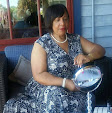Monday, July 30, 2012
Journey to Freedom
Why would a free black living in the North after having been emancipated voluntarily go back to the south risking being enslaved again? That question and many others were answered at the lecture and book signing of Lois Leveen, author of The Secrets of Mary Bowser, at the African American Museum & Library in Oakland on a sunny afternoon on Saturday, July 28, 2012.
The nation, especially the southern states are celebrating the sesquicentennial, actually it is easier to just say the 150th anniversary of the Civil War. As a native southerner— though California raised, and a regular visitor to the south, I have struggled with both my love for history, especially African American history, culture and literature and my love for the south and my dislike for reminders of such a painful period for black Americans and the nation and my feelings about southerners who still revel in their Civil War heroes and their proclamations for States rights. My love-hate relationship with the south and the Civil War makes me a reluctant student of Civil War history.
After listening to and meeting Dr. Lois Leveen, I think I somewhat have made peace with my ambiguous feelings. Lois was born and raised in New York, but as a lover of history and African American literature and history, became a student of the Civil War history by default. She is a regular contributor to Disunion, the New York Times coverage of the anniversary of the Civil War. She has taught history and literature at universities and is now lecturing at libraries, museums, universities, and bookstore on the same topic. She is also a feminist and has taught African American literature and history and has been influenced by bell hooks and June Jordan.
Dr. Leveen’s lecture consisted of three parts, Mary Bowser, Weaving History into Fiction and Reflecting on Making Up the Past. She first heard of Mary Bowser from reading A Shining Thread of Hope by Darlene Clark Hines and Kathleen Thompson. This book about black women in American history had a scant few lines about Bowser, a woman who was born into slavery, emancipated, educated and lived in Philadelphia, who went back to the south and became a slave again in order to aid in the abolition of slavery by becoming a spy in the Confederate White House under President Jefferson Davis. Wow! Powerful and mind-boggling, to say the least.
What kind of woman would do such a thing? Actually, Bowser’s life was not well documented, nor is there much evidence about her. Lois never meant to write a novel about Mary Bowser when she set out to research and write her story, but because of the lack of documentation, she culled from her extensive research and created an imagined life through fiction. She had a letter from Mary’s former owner, Elizabeth De Lew ib Richmong, Virginia and other documents and writings in which she was able to create the Mary Bowser in the book. It isn’t even certain the picture rumored to be Mary Bowser is in fact her. Unfortunately, Mary Bowser’s journals were discarded by her family in 1952. Though the evidence is sketchy, there is enough evidence to substantiate there was a Mary Browser and that she had an innate intelligence and photographic memory that served her well as a Civil War spy.
Why have most of us not heard of this woman? Well, for that matter, how many people know of other black woman heroes during the Civil War and Reconstruction and beyond? Most school children have heard of Harriett Tubman and Sojourner Truth? But how many know of Phillis Wheatley, Francis Watkins Harper, Mary McCleod Bethune, and Ida B. Wells? But hasn’t it always been that black women’s accomplishments were hidden and minimized? Zora Neale Hurston said the black woman was the mule of the world. How evident is that in American history?
Dr. Leveen’s lecture incited an excitement to research more about the Civil War, the south and about free blacks and their status in cities like Philadelphia, and other Eastern cities. Recent reading of both nonfiction and historical books has also added to my enthusiasm. I recently read nonfiction The Invisible Line: Three American Families and the Secret Journey from Black to White and The Right-Hand Shore by Christopher Tilghman which is fiction. Both of these books explore black life after the Civil War. Ironically, I am currently reading Freeman by Pulitzer prize-winning Leonard Pitts, Jr., a story about a man who has been free for 15 years, living in Philadelphia and who goes back to Mississippi at the end of the Civil War to look for his wife. Though this is fiction, Pitts’ research tells us this was not unusual. Former slaves set out to find their loved ones, even if it meant going back to a hostile south.
A book club member has already given her stamp of approval for The Secrets of Mary Bowser, so I am eager to get into it and read about real life characters that Leveen referred to such as David Bustill Bowser and Dangerfield Newby. Dr. Leveen posed the question of why was the Civil War a significant part of American history. Indeed her insightful presentation left me with a renewed interest in Civil War and slave and free black history.
July 29, 2012
Subscribe to:
Posts (Atom)


